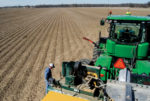Advertise Follow Us
Strip-Till Farming
Minnesota farmers Nancy and Jerry Ackermann credit strip-till, split nitrogen applications and cover crops for helping them reach 200-bushel corn yields on 140 pounds of nitrogen.
Read More
Transition to Twin-Row Strip-Till Increases Yields, Minimizes Erosion
Complementary systems help Nebraska farmer Clare Kurz increase yield by double digits and adopt a more economical fertility program.
Read More
Four Takeaways from the 2016 National Strip-Tillage Conference
The third annual event held in Bloomington-Normal, Ill., featured practical tips on cover cropping, increasing soil biology and improving nutrient management.
Read More
Strip-Till Operational Benchmark Study
Strip-Tilled Corn Acres, Soybean Yields Increase
The overall average of strip-tilled acres per farm grew by nearly 200, while average corn yields topped 190 and soybean yields jumped 4 bushels.
Read More
Strip-Till Operational Benchmark Study
Diversity of Methods Produce Strip-Till Stability and Flexibility
Increased adoption of cover crops and variable-rate fertilizing help strip-tillers maintain corn yields and increase soybean yields in 2015.
Read More
2nd Strip-Till Operational Benchmark Study: Cover Crop Use Spreads for Strip-Tillers
Strip-till corn populations remain consistent, while soybean seeding rates decline and use of twin-row systems increases.
Read More
2nd Strip-Till Operational Benchmark Study: Sidedressing Nitrogen, Use of Variable-Rate Fertilization on the Rise
Banded placement of P and K below the berm and use of RTK-level accuracy remain cornerstones of successful strip-till operations.
Read More
2nd Strip-Till Operational Benchmark Study: Acreage and Yields Increase for Strip-Tilled Corn and Soybeans
Farmers grew their total percentage of farm acres and average number of acres per farm being strip-tilled in 2014.
Read More
2nd Strip-Till Operational Benchmark Study: Improving Strip-Till Production with Precision Technology and Cover Crops
Ongoing adoption of cutting-edge practices and conservation-minded methods help boost strip-tilled corn and soybean yields.
Read More









